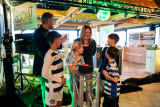AUAS contributes to accelerated roll-out of sustainable low-temperature heating networks in HeatNet project
The international research project HeatNet is all about making heat more sustainable. Less use of natural gas and more use of sustainable heat sources such as the residual heat from data centres. The project aimed to accelerate the roll-out of heating networks in urban areas. And that has been a success! Not only have new heating networks been developed in six European cities, the participating partners have gained knowledge about operating smartly in complex urban transitions. The professors and researcher involved from the Amsterdam University of Applied Sciences (AUAS) talk about the approach and the insights gained.
The role of the AUAS in the research project involves leading evaluations. During six evaluation meetings over three years, the partners reflected on their process of learning from each other and helping each other move forward. Professor of Energy and Innovation, Renée Heller: “As an evaluator, we not only wanted to determine how it went afterwards. But in accordance with the aim of this Interreg project – transnational learning – we embarked on a continuous learning process with each other.”
ON THE SHOULDERS OF GIANTS
This helps the pilot partners gain insights and build on each other’s discoveries. Frank Suurenbroek, professor of Spatial Urban Transformation: “In such complex transition projects, there is so much to consider. This process-based evaluation approach helps you gain insight into the issues you are facing. Such transitions are not a linear process and the insights cannot always be translated directly to other projects. But this approach does make complex processes navigable. It offers pathways for innovation that you can consider.”
The researchers translated this knowledge into various publications and guides, which have been made available to parties dealing with the roll-out of a heating network. Suurenbroek: “The Stakeholder Guide is also interesting for all parties that work on complex urban transitions.” Lecturer-researcher Egbert-Jan van Dijck was responsible for the development of the Stakeholder Guide.
“The heat transition requires an innovation at system level. Therefore, we carried out an extensive stakeholder analysis at meso-level,” explains Van Dijck. “It not only provides an impression of the individuals and organisations involved at the energy sector level, but also of their role in the chain, their interests and concerns. This step towards a situational analysis has enabled us to outline a holistic picture and carry out an in-depth analysis of barriers to the development of the new generation of heating and cooling networks in terms of finance, legislation and regulations and organisation.”
INVOLVING STUDENTS
“We are further expanding this analysis for education.” Van Dijck: Besides the human elements, we also analyse non-human elements, such as buildings, technologies, infrastructure, energy sources and subsurface. These are just as important in determining the situation as the human elements. For example, the pipes for a heating network cannot be laid through a river or a railway track. You need to be aware of these barriers.” Instead of just the people or the stakeholders, students see a much more complete situation at a glance. This goes for fourth-year students as well as second-year students.
Heller: “Several students have used this project for their graduation thesis. Students have even travelled to Ireland on their own initiative to learn more about the energy and heating situation there and to interview partners.”
ROLL-OUT OF HEATING NETWORKS
“There is a lot involved in creating a heating network,” says Heller. “Considering the complexity, it is unusual and significant that all six partners have succeeded in doing so in such a short space of time. It would be a shame not to use the valuable sources of heat available in a country. Data centres, for example, have a huge amount of heat left over. The roll-out of one heating network to multiple heating networks helps us to use available heat sources to increase sustainability and reduce our CO2 emissions.”
INTERDISCIPLINARY AND CROSS-THEMATIC
The HeatNet project is a good example of interdisciplinary collaboration between two research groups with different specialist knowledge. Frank Suurenbroek: “While the implementation of a heating network may appear to be a technical project, it is also an urban transformation process.” Heller adds: “Urban transition involves projects in which taking the energy leap seems the obvious choice, but where there is still little attention for the heat transition, while a great opportunity exists in that respect. Through our collaboration, we have seized that opportunity.”




